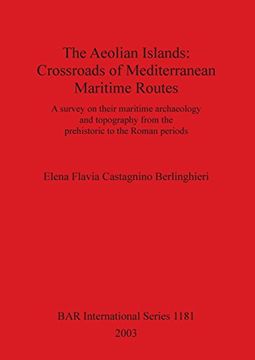The Aeolian Islands: Crossroads of Mediterranean Maritime Routes. A Survey on Their Maritime Archaeology and Topography From the Prehistoric to the Roman Periods (Bar International Series)
Synopsis "The Aeolian Islands: Crossroads of Mediterranean Maritime Routes. A Survey on Their Maritime Archaeology and Topography From the Prehistoric to the Roman Periods (Bar International Series)"
The Aeolian Islands, though a small archipelago, figured prominently in ancient civilisation. Their centrality in the south Tyrrhenian sea attracted the attention of outsiders, from the neighbouring regions in the eastern Mediterranean world in the proto-history period, to the Cnidians and Rhodians in the Archaic period and to the Romans afterwards; these groups controlled the islands as a whole or merely used them to exploit their strategic position together with the natural resources. When the proto-historic peoples or the Greeks or the Romans settled in the islands or even sailed off the islands they left highly distinctive remains of ancient maritime activity that came to light in the extensive excavations by Bernabò Brea and Cavalier. These archaeological remains either from land or underwater research have provided a wealth of maritime data, which has been exposed to partial analysis. Systematic work on Mediterranean seafaring society has greatly improved our knowledge of the maritime world that left such valuable data. These advances have occasioned a fresh context in which to plot the maritime activity data provided by the Aeolian Islands, and the time seems ripe for a re-examination of these data. This book intends to provide a detailed account of the Mediterranean maritime routes crossing the south Tyrrhenian through the Aeolian Islands from prehistory to Roman period. Within a chronological approach it presents a systematic study of archaeological sites found on the seabed around the Aeolian Islands and their relationship with historical events, as well as a view of the economy of the societies involved. In view of the variety of types of sites now lying below the sea's surface, a study of maritime archaeology requires a research strategy combining archaeological, geological, and marine meteorological data in order to identify the ancient coastlines and link the various finds to them. The archaeological sites involved in this work consist predominantly of wrecks of ancient ships and their cargoes. These are indisputable witnesses to the precise movements of the commercial activity of the times. Furthermore, they represent an important and unique sample of Mediterranean underwater heritage, which document almost four millennia of history. This book takes as its focus not only the wrecks of ancient ships and their cargoes, but also, wherever possible, the topography of maritime landing places, areas of anchorage and of shelter from prevailing winds, and thus of those sites related to ancient shipping and to the most heavily travelled routes of the Lower Tyrrhenian sea. The research strategy adopted is the result of a combination of archaeological, geological, and marine meteorological data, seeking to evaluate the interaction between two main maritime components, either in terms of the ancient economy or of the maritime landing places involved in the ancient seafaring world.

